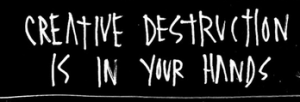
We have been entering some perilous times recently and I can’t imagine when Joseph Schumpeter outlined his groundbreaking efforts for explaining “creative destruction” he or anyone else, could imagine this being flipped around to what we are facing more today, in a more innovative era, that of “destructive creation”.
Schumpeter saw “creative destruction” as the renewing, through new innovation, society’s dynamics that would lead to higher levels of economic development and welfare.
At the same time recognizing that this destroyed a few of the incumbents to the benefit of many more newcomers and increasing value creation for broader society.
Today it seems we are caught in the reverse of this- the process of “destructive creation”- where it benefits a few rather than the many. This sets out often to destroy or greatly diminish the usage value of existing products and services before it is optimal to actually do so, and in the process incurring often significant costs not taken into account at the time.
These unforeseen issues have consequences that negatively affect parts of society not foreseen or contemplated at the time. Continue reading “The Innovating Era: Creative Destruction or Destructive Creation?”

